New Mexico Art Hour of Sun Passing Through Slit in Rock
| Georgia O'Keeffe | |
|---|---|
 O'Keeffe in 1918, photograph past Alfred Stieglitz | |
| Born | Georgia Totto O'Keeffe (1887-11-15)November 15, 1887 Sun Prairie, Wisconsin, U.S. |
| Died | March 6, 1986(1986-03-06) (anile 98) Santa Iron, New Mexico, U.Southward. |
| Education | School of the Fine art Institute of Chicago Columbia College Teachers College, Columbia Academy University of Virginia Fine art Students League of New York |
| Known for | Painting |
| Movement | American modernism, Precisionism |
| Spouse(s) | Alfred Stieglitz (m. 1924; died ) |
| Family | Ida O'Keeffe (sister) |
| Awards | National Medal of Arts (1985) Presidential Medal of Freedom (1977) Edward MacDowell Medal (1972) |
Georgia Totto O'Keeffe (Nov 15, 1887 – March 6, 1986) was an American modernist creative person. She was known for her paintings of enlarged flowers, New York skyscrapers, and New Mexico landscapes. O'Keeffe has been called the "Mother of American modernism".[one] [two]
In 1905, O'Keeffe began art grooming at the Schoolhouse of the Art Establish of Chicago[3] and and so the Art Students League of New York. In 1908, unable to fund farther pedagogy, she worked for 2 years equally a commercial illustrator and then taught in Virginia, Texas, and South Carolina between 1911 and 1918. She studied art in the summers between 1912 and 1914 and was introduced to the principles and philosophies of Arthur Wesley Dow, who created works of art based upon personal mode, design, and estimation of subjects, rather than trying to copy or stand for them. This caused a major alter in the fashion she felt about and approached art, as seen in the beginning stages of her watercolors from her studies at the University of Virginia and more dramatically in the charcoal drawings that she produced in 1915 that led to total brainchild. Alfred Stieglitz, an art dealer and lensman, held an exhibit of her works in 1917.[4] Over the next couple of years, she taught and continued her studies at the Teachers Higher, Columbia University.
She moved to New York in 1918 at Stieglitz'southward request and began working seriously as an artist. They developed a professional and personal relationship that led to their spousal relationship in 1924. O'Keeffe created many forms of abstract art, including close-ups of flowers, such as the Red Canna paintings, that many constitute to represent vulvas,[five] though O'Keeffe consistently denied that intention.[6] The imputation of the depiction of women'southward sexuality was as well fueled by explicit and sensuous photographs of O'Keeffe that Stieglitz had taken and exhibited.
O'Keeffe and Stieglitz lived together in New York until 1929, when O'Keeffe began spending part of the twelvemonth in the Southwest, which served as inspiration for her paintings of New Mexico landscapes and images of fauna skulls, such every bit Cow'south Skull: Ruddy, White, and Blue and Ram'due south Head White Hollyhock and Piddling Hills. Later Stieglitz's expiry, she lived in New Mexico at Georgia O'Keeffe Home and Studio in Abiquiú until the final years of her life, when she lived in Santa Iron. In 2014, O'Keeffe'southward 1932 painting Jimson Weed/White Flower No. i sold for $44,405,000, more than than three times the previous world auction record for whatever female person creative person.[vii] After her death, the Georgia O'Keeffe Museum was established in Santa Iron.
Early life [edit]
Georgia O'Keeffe was born on November 15, 1887,[2] [8] in a farmhouse in the boondocks of Sun Prairie, Wisconsin.[9] [ten] Her parents, Francis Calyxtus O'Keeffe and Ida (Totto) O'Keeffe, were dairy farmers. Her father was of Irish descent. Her maternal grandfather, George Victor Totto, for whom O'Keeffe was named, was a Hungarian count who came to the Us in 1848.[two] [11]
O'Keeffe was the 2nd of 7 children.[2] She attended Town Hall School in Sun Prairie.[12] By historic period x, she had decided to get an artist,[13] and with her sisters, Ida and Anita,[fourteen] she received art instruction from local watercolorist Sara Isle of mann. O'Keeffe attended loftier school at Sacred Centre Academy in Madison, Wisconsin, as a boarder betwixt 1901 and 1902. In tardily 1902, the O'Keeffes moved from Wisconsin to the shut-knit neighborhood of Peacock Hill in Williamsburg, Virginia, where O'Keeffe'due south father started a business making rusticated cast physical cake in anticipation of a need for the block in the Peninsula edifice trade, but the need never materialized.[15] O'Keeffe stayed in Wisconsin with her aunt attending Madison Central High School[16] until joining her family in Virginia in 1903. She completed high school as a boarder at Chatham Episcopal Institute in Virginia (now Chatham Hall), graduating in 1905. At Chatham, she was a fellow member of Kappa Delta sorority.[ii] [12]
O'Keeffe taught and headed the art department at West Texas Country Normal College, watching over her youngest sibling, Claudia, at her mother's request.[17] In 1917, she visited her brother, Alexis, at a armed forces army camp in Texas before he shipped out for Europe during Earth War I. While there, she created the painting The Flag,[18] which expressed her anxiety and depression about the war.[19]
Career [edit]
Pedagogy and early career [edit]
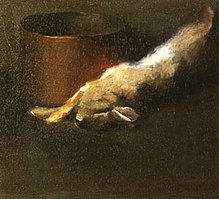
Georgia O'Keeffe, Untitled, 1908, Art Students League of New York collection
From 1905 to 1906, O'Keeffe was enrolled at the School of the Art Plant of Chicago, where she studied with John Vanderpoel and ranked at the top of her class.[2] [xiii] As a result of contracting typhoid fever, she had to have a twelvemonth off from her didactics.[ii] In 1907, she attended the Art Students League in New York City, where she studied nether William Merritt Hunt, Kenyon Cox, and F. Luis Mora.[2] In 1908, she won the League'southward William Merritt Chase all the same-life prize for her oil painting Dead Rabbit with Copper Pot. Her prize was a scholarship to attend the League's outdoor summertime school in Lake George, New York.[two] While in the New York Urban center, O'Keeffe visited galleries, such as 291, co-owned by her time to come hubby, photographer Alfred Stieglitz. The gallery promoted the work of avant-garde artists and photographers from the United States and Europe.[ii]
In 1908, O'Keeffe discovered that she would not exist able to finance her studies. Her father had gone bankrupt and her mother was seriously sick with tuberculosis.[ii] She was not interested in a career every bit a painter based on the mimetic tradition that had formed the basis of her art training.[13] She took a job in Chicago as a commercial artist and worked there until 1910, when she returned to Virginia to recuperate from the measles[20] and subsequently moved with her family to Charlottesville, Virginia.[2] She did not paint for iv years and said that the smell of turpentine made her ill.[13] She began teaching art in 1911. One of her positions was at her erstwhile schoolhouse, Chatham Episcopal Institute, in Virginia.[two] [21]
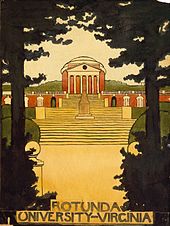
She took a summertime art form in 1912 at the University of Virginia from Alon Bement, who was a Columbia Academy Teachers College faculty fellow member. Under Bement, she learned of the innovative ideas of Arthur Wesley Dow, Bement's colleague. Dow's arroyo was influenced by principles of design and composition in Japanese art. She began to experiment with abstract compositions and develop a personal style that veered abroad from realism.[2] [13] From 1912 to 1914, she taught art in the public schools in Amarillo in the Texas Panhandle, and was a instruction assistant to Bement during the summers.[2] She took classes at the University of Virginia for 2 more summers.[22] She also took a grade in the jump of 1914 at Teachers College of Columbia University with Dow, who further influenced her thinking about the process of making art.[23] Her studies at the University of Virginia, based upon Dow'due south principles, were pivotal in O'Keeffe's development as an artist. Through her exploration and growth every bit an creative person, she helped to establish the American modernism move.

She taught at Columbia Higher in Columbia, Southward Carolina in tardily 1915, where she completed a series of highly innovative charcoal abstractions[13] based on her personal sensations.[21] In early 1916, O'Keeffe was in New York at Teachers Higher, Columbia University. She mailed the charcoal drawings to a friend and onetime classmate at Teachers Higher, Anita Pollitzer, who took them to Alfred Stieglitz at his 291 gallery early in 1916.[24] Stieglitz plant them to be the "purest, finest, sincerest things that had entered 291 in a long while", and said that he would similar to evidence them. In April that year, Stieglitz exhibited 10 of her drawings at 291.[ii] [13]

After further course piece of work at Columbia in early 1916 and summertime teaching for Bement,[2] she became the chair of the art department at Due west Texas State Normal Higher, in Canyon, Texas beginning in the fall of 1916.[25] She began a series of watercolor paintings based upon the scenery and expansive views during her walks,[21] [26] including vibrant paintings of Palo Duro Coulee.[27] O'Keeffe, who enjoyed sunrises and sunsets, developed a fondness for intense and nocturnal colors. Edifice upon a exercise she began in Due south Carolina, O'Keeffe painted to express her most private sensations and feelings. Rather than sketching out a design earlier painting, she freely created designs. O'Keeffe continued to experiment until she believed she truly captured her feelings in the watercolor, Calorie-free Coming on the Plains No. I (1917).[21] She "captured a monumental mural in this simple configuration, fusing bluish and green pigments in almost indistinct tonal graduations that simulate the pulsating effect of low-cal on the horizon of the Texas Panhandle," according to author Sharyn Rohlfsen Udall.[21] [26] Later her human relationship with Alfred Stieglitz started, her watercolor paintings ended quickly. Stieglitz heavily encouraged her to quit because the apply of watercolor was associated with amateur women artists.[28]
New York [edit]
Stieglitz, 24 years older than O'Keeffe,[28] provided financial support and arranged for a residence and place for her to pigment in New York in 1918. They developed a close personal human relationship while he promoted her work.[2] She came to know the many early on American modernists who were part of Stieglitz'southward circle of artists, including painters Charles Demuth, Arthur Dove, Marsden Hartley, John Marin, and photographers Paul Strand and Edward Steichen. Strand's photography, likewise equally that of Stieglitz and his many photographer friends, inspired O'Keeffe'south work. Also around this time, O'Keeffe became sick during the 1918 flu pandemic.[11]

O'Keeffe began creating simplified images of natural things, such every bit leaves, flowers, and rocks.[29] Inspired by Precisionism, The Green Apple, completed in 1922, depicts her notion of uncomplicated, meaningful life.[30] O'Keeffe said that year, "it is only by selection, by emptying, and by emphasis that we get at the real significant of things."[30] Blue and Greenish Music expresses O'Keeffe'southward feelings virtually music through visual art, using assuming and subtle colors.[31]
Likewise in 1922, journalist Paul Rosenfeld commented "[the] Essence of very womanhood permeates her pictures", citing her use of colour and shapes as metaphors for the female body.[32] This same article also describes her paintings in a sexual way.[32]
O'Keeffe, most famous for her depiction of flowers, made about 200 flower paintings,[33] which by the mid-1920s were big-calibration depictions of flowers, as if seen through a magnifying lens, such as Oriental Poppies [34] [35] and several Scarlet Canna paintings.[36] She painted her showtime large-calibration flower painting, Petunia, No. ii, in 1924 and information technology was start exhibited in 1925.[2] Making magnified depictions of objects created a sense of awe and emotional intensity.[29] On Nov 20, 2014, O'Keeffe's Jimson Weed/White Blossom No 1 (1932) sold for $44,405,000 in 2014 at auction to Walmart heiress Alice Walton, more than three times the previous globe auction record for whatsoever female artist.[37] [38]
Art historian Linda Nochlin interpreted Black Iris 3 (1926) as a morphological metaphor for a vulva, but O'Keeffe rejected that estimation, challenge they were just pictures of flowers.[39] [40]
After having moved into a 30th floor apartment in the Shelton Hotel in 1925,[41] O'Keeffe began a series of paintings of the metropolis skyscrapers and skyline.[42] One of her most notable works, which demonstrates her skill at depicting the buildings in the Precisionist manner, is the Radiator Building – Night, New York.[43] [44] Other examples are New York Street with Moon (1925),[45] The Shelton with Sunspots, N.Y. (1926),[46] and City Nighttime (1926).[2] She fabricated a cityscape, East River from the Thirtieth Story of the Shelton Hotel in 1928, a painting of her view of the Eastward River and smoke-emitting factories in Queens.[42] The next year she made her final New York City skyline and skyscraper paintings and traveled to New United mexican states, which became a source of inspiration for her work.[43]
In 1924, Stieglitz arranged a simultaneous exhibit of O'Keeffe'southward works of art and his photographs at Anderson Galleries and bundled for other major exhibits.[47] The Brooklyn Museum held a retrospective of her work in 1927.[24] In 1928, Stieglitz announced that six of her calla lily paintings sold to an anonymous buyer in France for U.s.$25,000, but there is no evidence that this transaction occurred the style Stieglitz reported.[ citation needed ] As a result of the press attending, O'Keeffe's paintings sold at a higher price from that point onward.[48] [49] By the tardily 1920s she was noted for her work depicting American subjects, particularly for the paintings of New York city skyscrapers and close-up paintings of flowers.[47]
Taos [edit]
O'Keeffe traveled to New Mexico past 1929 with her friend Rebecca Strand and stayed in Taos with Mabel Dodge Luhan, who provided the women with studios.[50] From her room she had a clear view of the Taos Mountains as well as the morada (meetinghouse) of the Hermanos de la Fraternidad Piadosa de Nuestro Padre Jesús Nazareno aka the Penitentes.[51] O'Keeffe went on many pack trips, exploring the rugged mountains and deserts of the region that summertime and later on visited the nearby D. H. Lawrence Ranch,[50] where she completed her at present famous oil painting, The Lawrence Tree, currently endemic by the Wadsworth Athenaeum in Hartford, Connecticut.[52] O'Keeffe visited and painted the nearby historical San Francisco de Asis Mission Church at Ranchos de Taos. She made several paintings of the church, as had many artists, and her painting of a fragment of it silhouetted against the sky captured information technology from a unique perspective.[53] [54]
New Mexico and New York [edit]
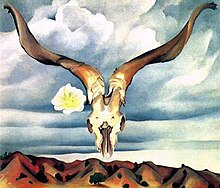
Georgia O'Keeffe, Ram's Head White Hollyhock and Petty Hills, 1935, The Brooklyn Museum
O'Keeffe and then spent part of nearly every twelvemonth working in New Mexico. She collected rocks and bones from the desert flooring and made them and the distinctive architectural and mural forms of the area subjects in her work.[29] Known equally a loner, O'Keeffe often explored the land she loved in her Ford Model A, which she purchased and learned to drive in 1929. She oftentimes talked about her fondness for Ghost Ranch and Northern New Mexico, as in 1943, when she explained, "Such a beautiful, untouched lonely feeling place, such a fine part of what I phone call the 'Faraway'. It is a place I have painted earlier ... even now I must do information technology once again."[54]
O'Keeffe did non work from belatedly 1932 until virtually the mid-1930s [54] as she endured diverse nervous breakdowns and was admitted to a psychiatric hospital.[28] These nervous breakdowns were the result of O'Keeffe learning of her husband's affair.[28] She was a popular artist, receiving commissions while her works were being exhibited in New York and other places.[55] In 1936, she completed what would go i of her all-time-known paintings, Summer Days. It depicts a desert scene with a deer skull with vibrant wildflowers. Resembling Ram's Head with Hollyhock, it depicted the skull floating above the horizon.[55] [56]
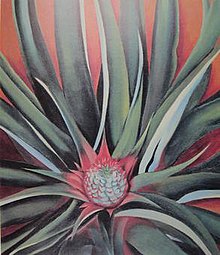
Pineapple Bud, 1939, oil on canvas
In 1938, the advertizement agency Due north. Westward. Ayer & Son approached O'Keeffe about creating 2 paintings for the Hawaiian Pineapple Visitor (now Dole Nutrient Visitor) to use in advertising.[57] [58] [59] Other artists who produced paintings of Hawaii for the Hawaiian Pineapple Company'southward advertizing include Lloyd Sexton, Jr., Millard Sheets, Yasuo Kuniyoshi, Isamu Noguchi, and Miguel Covarrubias.[threescore] The offering came at a critical time in O'Keeffe'southward life: she was 51, and her career seemed to be stalling (critics were calling her focus on New Mexico limited, and branding her desert images "a kind of mass production").[61] She arrived in Honolulu February viii, 1939, aboard the SS Lurline and spent nine weeks in Oahu, Maui, Kauai, and the island of Hawaii. By far the most productive and vivid menstruation was on Maui, where she was given complete freedom to explore and paint.[61] [62] She painted flowers, landscapes, and traditional Hawaiian fishhooks. Back in New York, O'Keeffe completed a series of 20 sensual, verdant paintings. However, she did not pigment the requested pineapple until the Hawaiian Pineapple Company sent a constitute to her New York studio.[63]
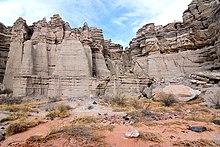
O'Keeffe's "White Place", the Plaza Blanca cliffs and badlands near Abiquiú
During the 1940s, O'Keeffe had two one-woman retrospectives, the first at the Art Institute of Chicago (1943).[29] Her second was in 1946, when she was the outset woman artist to have a retrospective at the Museum of Modern Fine art (MoMA) in Manhattan.[33] Whitney Museum of American Art began an try to create the first catalogue of her work in the mid-1940s.[55]
In the 1940s, O'Keeffe fabricated an extensive series of paintings of what is called the "Black Place", about 150 miles (240 km) west of her Ghost Ranch house.[64] O'Keeffe said that the Black Place resembled "a mile of elephants with gray hills and white sand at their feet."[54] She fabricated paintings of the "White Place", a white rock germination located near her Abiquiú house.[65]
Abiquiú [edit]
| External images | |
|---|---|
| | |
| |
In 1946, she began making the architectural forms of her Abiquiú house—patio wall and door—subjects in her piece of work.[66] Another distinctive painting was Ladder to the Moon, 1958.[67] O'Keeffe produced a series of cloudscape art, such as Heaven to a higher place the Clouds in the mid-1960s that were inspired past her views from airplane windows.[29]
Worcester Art Museum held a retrospective of her work in 1960[24] and ten years subsequently, the Whitney Museum of American Art mounted the Georgia O'Keeffe Retrospective Exhibition.[47]
In 1972, O'Keeffe lost much of her eyesight due to macular degeneration, leaving her with just peripheral vision. She stopped oil painting without assistance in 1972.[68] In the 1970s, she made a series of works in watercolor.[69] Her autobiography, Georgia O'Keeffe, published in 1976 was a best seller.[47]
Judy Chicago gave O'Keeffe a prominent identify in her The Dinner Party (1979) in recognition of what many prominent feminist artists considered groundbreaking introduction of sensual and feminist imagery in her works of art.[70] Although feminists historic O'Keeffe as the originator of "female person iconography",[71] O'Keeffe refused to join the feminist art movement or cooperate with any all-women projects.[72] She disliked being called a "woman artist" and wanted to be considered an "artist."[73]
She continued working in pencil and charcoal until 1984.[68]
O'Keeffe's Flowers every bit Vulvas and Criticism [edit]
O'Keeffe's lotus paintings may have deeper ties to vulvar imagery and symbolism. In Egyptian mythology, lotus flowers are a symbol of the womb, and in Indian mythology, they are straight symbols for vulvas.[74]
Art dealer Samuel Kootz was one of O'Keeffe's critics who although stated she was "the only prominent woman artist", had contrasting opinions.[75] Kootz stated that "assertion of sex tin can just impede the talents of an creative person, for an human activity of defiance, of grievance, in which the consciousness of these qualities retards the natural assertions of the painter".[75] He insisted that there had to be a phallic meaning behind her unique artwork. Nevertheless, O'Keeffe stood her ground and for fifty years maintained that there was no connection between vulvas and her artwork.[75]
Firing back to some of the criticism, O'Keeffe stated "When people read erotic symbols into my paintings, they're really talking about their own diplomacy."[76] She refuted this by proverb projection was the reason behind other artists' attacks on her work. O'Keeffe was also seen every bit a revolutionary feminist; however, the artist rejected these notions stating "femaleness is irrelevant" and that "it has zero to do with fine art making or accomplishment."[77]
Awards and honors [edit]
In 1938, O'Keeffe received an honorary degree of "Doctor of Fine Arts" from The Higher of William & Mary.[78] After, O'Keeffe was elected to the American Academy of Arts and Letters[24] and in 1966 was elected a Boyfriend of the American University of Arts and Sciences.[79] Amid her awards and honors, O'Keeffe received the M. Carey Thomas Award at Bryn Mawr College in 1971 and ii years after received an honorary caste from Harvard University.[24]
In 1977, President Gerald Ford presented O'Keeffe with the Presidential Medal of Freedom, the highest honor awarded to American civilians.[lxxx] In 1985, she was awarded the National Medal of Arts past President Ronald Reagan.[47] In 1993, she was inducted into the National Women'due south Hall of Fame.[81]
Personal life and death [edit]
Marriage [edit]
In June 1918, O'Keeffe accepted Stieglitz's invitation to move to New York from Texas afterward he promised he would provide her with a tranquillity studio where she could pigment. Within a month he took the first of many nude photographs of her at his family's apartment while his married woman was abroad. His wife returned habitation once while their session was nonetheless in progress. She had suspected for a while that something was going on between the ii, and told him to terminate seeing O'Keeffe or get out. Stieglitz left home immediately and plant a place in the metropolis where he and O'Keeffe could live together. They slept separately for more two weeks. By the stop of the calendar month they were in the same bed together, and by mid-August when they visited Oaklawn, the Stieglitz family summer estate in Lake George in upstate New York, "they were like two teenagers in love. Several times a day they would run upward the stairs to their bedroom, so eager to make love that they would first taking their apparel off equally they ran."

In Feb 1921, Stieglitz's photographs of O'Keeffe were included in a retrospective exhibition at the Anderson Galleries. Stieglitz started photographing O'Keeffe when she visited him in New York City to run across her 1917 exhibition, and connected taking photographs, many of which were in the nude. It created a public sensation. When he retired from photography in 1937, he had made more than 350 portraits and more than than 200 nude photos of her.[29] [82] In 1978, she wrote about how distant from them she had get, "When I look over the photographs Stieglitz took of me—some of them more than sixty years agone—I wonder who that person is. Information technology is as if in my one life I have lived many lives."[83]
Attributable to the legal delays caused past Stieglitz's beginning married woman and her family, information technology would have 6 years before he obtained a divorce. In 1924, O'Keeffe and Stieglitz got married.[47] For the rest of their lives together, their relationship was, "a collusion....a system of deals and trade-offs, tacitly agreed to and carried out, for the nearly function, without the exchange of a word. Preferring avoidance to confrontation on virtually problems, O'Keeffe was the principal agent of collusion in their union," according to biographer Benita Eisler.[84] They lived primarily in New York City, merely spent their summers at his male parent's family estate, Oaklawn, in Lake George in upstate New York.[47]
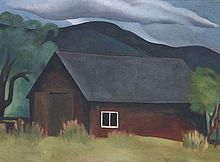
Mental health [edit]
O'Keeffe's mental health was fragile. In 1928, Stieglitz began a long-term thing with Dorothy Norman, who was also married, and O'Keeffe lost a project to create a landscape for Radio Metropolis Music Hall. She was hospitalized for low.[29] At the suggestion of Maria Chabot and Mabel Dodge Luhan, O'Keeffe began to spend the summers painting in New Mexico in 1929.[47] She traveled by train with her friend the painter Rebecca Strand, Paul Strand'due south married woman, to Taos, where they lived with their patron who provided them with studios.[50]
Hospitalization [edit]
In 1933, O'Keeffe was hospitalized for two months after suffering a nervous breakdown, largely due to Stieglitz's thing with Dorothy Norman.[85] She did non paint again until Jan 1934. In 1933 and 1934, O'Keeffe recuperated in Bermuda and returned to New Mexico in 1934. In August 1934, she moved to Ghost Ranch, north of Abiquiú. In 1940, she moved into a house on the ranch belongings. The varicolored cliffs surrounding the ranch inspired some of her most famous landscapes.[54] Amidst guests to visit her at the ranch over the years were Charles and Anne Lindbergh, singer-songwriter Joni Mitchell, poet Allen Ginsberg, and photographer Ansel Adams.[86] She traveled and camped at "Black Identify" often with her friend, Maria Chabot, and afterward with Eliot Porter.[54] [64]
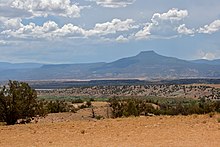
Cerro Pedernal, viewed from Ghost Ranch. This was a favorite field of study for O'Keeffe, who once said, "It'due south my private mount. Information technology belongs to me. God told me if I painted it plenty, I could have information technology"[87] [88]

Painting materials every bit displayed at the O'Keeffe Museum in Santa Fe, NM
New commencement [edit]
In 1945, O'Keeffe bought a second house, an abandoned hacienda in Abiquiú, which she renovated into a home and studio.[89] Shortly afterward O'Keeffe arrived for the summer in New Mexico in 1946, Stieglitz suffered a cerebral thrombosis (stroke). She immediately flew to New York to be with him. He died on July xiii, 1946. She buried his ashes at Lake George.[90] She spent the side by side three years more often than not in New York settling his manor,[29] and then moved permanently to New Mexico in 1949, spending time at both Ghost Ranch and the Abiquiú house that she made into her studio.[29] [47]
Todd Webb, a photographer she met in the 1940s, moved to New Mexico in 1961. He often made photographs of her, as did numerous other important American photographers, who consistently presented O'Keeffe as a "loner, a severe figure and cocky-fabricated person."[91] While O'Keeffe was known to take a "prickly personality," Webb's photographs portray her with a kind of "quietness and at-home" suggesting a relaxed friendship, and revealing new contours of O'Keeffe's character.[92]
Travels [edit]
O'Keeffe enjoyed traveling to Europe, and around the world, offset in the 1950s. Several times she took rafting trips down the Colorado River,[24] including a trip downwards the Glen Canyon, Utah, area in 1961 with Webb and photographer Eliot Porter.[54]
Career end and death [edit]
In 1973, O'Keeffe hired John Bruce "Juan" Hamilton as a live-in assistant and and so a caretaker. Hamilton was a potter, recently divorced and broke. This last years companion was 58 years her inferior.[93] Hamilton taught O'Keeffe to work with clay, encouraged her to resume painting despite her deteriorating eyesight, and helped her write her autobiography. He worked for her for thirteen years.[29] O'Keeffe became increasingly frail in her late 90s. She moved to Santa Fe in 1984, where she died on March half-dozen, 1986, at the age of 98.[94] Her body was cremated and her ashes were scattered, as she wished, on the land effectually Ghost Ranch.[95]
Estate settlement [edit]
Following O'Keeffe'southward decease, her family unit contested her will because codicils added to information technology in the 1980s had left nigh of her $65 million estate to Hamilton. The instance was ultimately settled out of courtroom in July 1987.[95] [96] The case became a famous precedent in estate planning.[97] [98]
Paintings [edit]
-
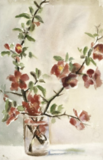
O'Keeffe, Untitled – vase of flowers, 1903–1905, watercolor on paper, Georgia O'Keeffe Museum
-
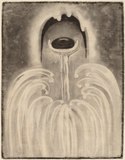
O'Keeffe, Drawing No. 2 – Special, 1915, charcoal on laid paper, 23.6 by eighteen.2 inches (threescore cm × 46.3 cm), National Gallery of Art
-
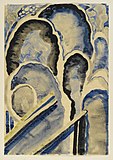
O'Keeffe, Blue #1, 1916, watercolor and graphite on paper, Brooklyn Museum
-

O'Keeffe, Sunrise, 1916, watercolor on paper
-

O'Keeffe, Series 1, No. 8, 1918, oil-painting on canvas, 20.0 by 16.0 inches (50.8 cm × 40.6 cm), Lenbachhaus, Munich
-

O'Keeffe, A Tempest, 1922, pastel on newspaper, mounted on illustration board, 18.3 by 24.4 inches (46.four cm × 61.9 cm) Metropolitan Museum of Art
Legacy [edit]
| External video | |
|---|---|
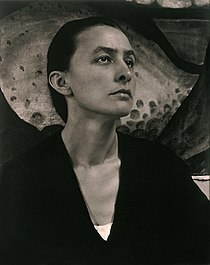 | |
| |
O'Keeffe was a legend beginning in the 1920s, known as much for her contained spirit and female function model equally for her dramatic and innovative works of art.[95] Nancy and Jules Heller said, "The most remarkable thing nearly O'Keeffe was the audacity and uniqueness of her early work." At that time, fifty-fifty in Europe, at that place were few artists exploring abstraction. Even though her works may show elements of different modernist movements, such every bit Surrealism and Precisionism, her work is uniquely her own style.[99] She received unprecedented credence as a adult female artist from the fine art globe due to her powerful graphic images and within a decade of moving to New York City, she was the highest-paid American adult female artist.[100] She was known for a distinctive style in all aspects of her life.[101] O'Keeffe was besides known for her relationship with Stieglitz, in which she provided some insight in her autobiography.[95] The Georgia O'Keeffe Museum says that she was i of the offset American artists to practice pure abstraction.[2]
Mary Beth Edelson's Some Living American Women Artists / Terminal Supper (1972) appropriated Leonardo da Vinci'due south The Terminal Supper, with the heads of notable women artists collaged over the heads of Christ and his apostles. John the Apostle's head was replaced with Nancy Graves, and Christ'southward with Georgia O'Keeffe. This image, addressing the role of religious and art historical iconography in the subordination of women, became "ane of the most iconic images of the feminist art motion."[102] [103]
A substantial part of her manor's assets were transferred to the Georgia O'Keeffe Foundation, a nonprofit. The Georgia O'Keeffe Museum opened in Santa Fe in 1997.[95] The assets included a large body of her work, photographs, archival materials, and her Abiquiú house, library, and property. The Georgia O'Keeffe Domicile and Studio in Abiquiú was designated a National Historic Landmark in 1998, and is now owned by the Georgia O'Keeffe Museum.[89]
In 1996, the U.South. Postal Service issued a 32-cent stamp honoring O'Keeffe.[104] In 2013, on the 100th ceremony of the Armory Show, the USPS issued a stamp featuring O'Keeffe'due south Black Mesa Landscape, New Mexico/Out Dorsum of Marie's Ii, 1930 as part of their Modern Art in America series.[105]
A fossilized species of archosaur was named Effigia okeeffeae ("O'Keeffe's Ghost") in January 2006, "in honor of Georgia O'Keeffe for her numerous paintings of the badlands at Ghost Ranch and her interest in the Coelophysis Quarry when information technology was discovered".[106]
In Nov 2016, the Georgia O'Keeffe Museum recognized the importance of her fourth dimension in Charlottesville by dedicating an exhibition, using watercolors that she had created over iii summers. It was entitled, O'Keeffe at the University of Virginia, 1912–1914.[22]
O'Keeffe holds the record ($44.4 million in 2014) for the highest cost paid for a painting by a woman.[107]
In 1991, PBS aired the American Playhouse production A Marriage: Georgia O'Keeffe and Alfred Stieglitz, starring Jane Alexander as O'Keeffe and Christopher Plummer equally Alfred Stieglitz.[108]
Lifetime Television produced a biopic of Georgia O'Keeffe starring Joan Allen as O'Keeffe, Jeremy Irons as Alfred Stieglitz, Henry Simmons as Jean Toomer, Ed Begley Jr. as Stieglitz's brother Lee, and Tyne Daly every bit Mabel Dodge Luhan. It premiered on September 19, 2009.[109] [110]
Publications [edit]
- O'Keeffe, Georgia (1976). Georgia O'Keeffe. New York: Viking Press. ISBN978-0-670-33710-1.
- O'Keeffe, Georgia (1988). Some Memories of Drawings. Albuquerque, NM: University of New United mexican states Press. ISBN978-0-8263-1113-ix.
- Giboire, Clive, ed. (1990). Lovingly, Georgia: The Complete Correspondence of Georgia O'Keeffe & Anita Pollitzer . New York: Simon & Schuster. ISBN978-0-671-69236-0.
- O'Keeffe, Georgia (1993). Georgia O'Keeffe : American and modernistic. New Haven: Yale University. ISBN978-0-300-05581-eight.
- Greenough, Sarah, ed. (2011). My Faraway One: Selected Letters of Georgia O'Keeffe and Alfred Stieglitz. Vol. One, 1915–1933 (Annotated ed.). New Oasis, CT: Yale University Press. ISBN978-0-300-16630-9.
- Buhler Lynes, Barbara (2012). Georgia O'Keeffe and Her Houses: Ghost Ranch and Abiquiu. Harry N. Abrams. ISBN978-1-4197-0394-2.
- Winter, Jeanette (1998). My Name is Georgia: A Portrait. San Diego, New York, London: Kickoff Voyager Books. ISBN0-xv-201649-10.
References [edit]
- ^ a b "Life and Artwork of Georgia O'Keeffe". C-Span. Jan 9, 2013. Retrieved March fourteen, 2013.
- ^ a b c d e f g h i j 1000 l 1000 n o p q r s t u "Georgia O'Keeffe". Biography Channel. A&E Television Networks. Baronial 26, 2016. Archived from the original on January 16, 2017. Retrieved January 14, 2017.
- ^ "Georgia O'Keeffe | American painter". Encyclopedia Britannica. Archived from the original on September 29, 2019. Retrieved October eleven, 2019.
- ^ Christiane, Weidemann (2008). 50 women artists you should know . Larass, Petra., Klier, Melanie. Munich: Prestel. ISBN978-3-7913-3956-6. OCLC 195744889. Archived from the original on April 4, 2020. Retrieved March 4, 2020.
- ^ "An unabashedly sensual approach to a genteel genre". Newsweek. 110: 74–75. November 9, 1987 – via Readers' Guide Abstracts.
- ^ Avishai, Tamar. "Episode 45: Georgia O'Keeffe'southward Deer's Skull With Pedernal (1936)". The Lonely Palette (Podcast). Retrieved December 25, 2020.
- ^ Rile, Karen (December ane, 2014). "Georgia O'Keeffe and the $44 Million Jimson Weed". JSTOR Daily . Retrieved March 31, 2022.
- ^ "Birth Record Details". Wisconsin Historical Social club. Archived from the original on November 7, 2012. Retrieved July 23, 2009.
- ^ "Birthplace of Georgia O'Keeffe". Dominicus Prairie, WI. Archived from the original on July 29, 2017.
- ^ Wisconsin Legislature. 2013–xiv Wisconsin Statutes 2013–xiv S.84.1021 Georgia O'Keeffe Memorial Highway. Archived September 28, 2015, at the Wayback Machine
- ^ a b Roxana Robinson (1989). Georgia O'Keeffe: A Life. University Press of New England. p. 193. ISBN0-87451-906-3.
- ^ a b Nancy Hopkins Reily (2007). Georgia O'keeffe, a Private Friendship: Walking the Sun Prairie Country. Sunstone Press. p. 54. ISBN978-0-86534-451-8.
- ^ a b c d due east f grand Roberts, Norma J., ed. (1988), The American Collections, Columbus Museum of Art, p. 76, ISBN0-8109-1811-0
- ^ Canterbury, Sue (2018). Ida O'Keeffe: Escaping Georgia'south Shadow. Dallas, Texas: Dallas Museum of Art. p. xv. ISBN978-0-300-21456-7.
- ^ "Colonial Williamsburg Research & Education". world wide web.colonialwilliamsburg.org. Archived from the original on April ix, 2020. Retrieved April 9, 2020.
- ^ "Blogger". accounts.google.com.
- ^ Gerry Souter (2017). Georgia O'Keeffe. Parkstone International. pp. 34–35. ISBN978-5-457-46766-8.
- ^ Kingdom of the netherlands Cotter (January 5, 2017). "World War I – The Quick. The Expressionless. The Artists". The New York Times. Archived from the original on January 11, 2017. Retrieved Jan 16, 2017.
- ^ Roxana Robinson; Georgia O'Keeffe (1989). Georgia O'Keeffe: A Life. University Printing of New England. pp. 191–193. ISBN978-0-87451-906-8.
- ^ Kathaleen Roberts (Nov twenty, 2016). "Never-before-exhibited O'Keeffe paintings testify shift to abstraction". Albuquerque Journal. Archived from the original on January 16, 2017. Retrieved January 14, 2017.
- ^ a b c d e Amon Carter Museum of Western Art; Patricia A. Junker; Will Gillham (2001). An American Drove: Works from the Amon Carter Museum. Hudson Hills. p. 184. ISBN978-1-55595-198-6.
- ^ a b "How UVA shaped Georgia O'Keeffe". University of Virginia. November 10, 2016. Archived from the original on January 16, 2017. Retrieved January fourteen, 2017.
- ^ Zilczer, Judith (1999). "'Light Coming on the Plains': Georgia O'Keeffe's Sunrise Serial". Artibus et Historiae. 20 (40): 193–194. doi:10.2307/1483675. JSTOR 1483675.
- ^ a b c d east f Eleanor Tufts; National Museum of Women in the Arts; International Exhibitions Foundation (1987). American women artists, 1830–1930. International Exhibitions Foundation for the National Museum of Women in the Arts. p. 81. ISBN978-0-940979-01-vii. Archived from the original on April 27, 2017. Retrieved January 20, 2017.
- ^ Zilczer, Judith (1999). "'Light Coming on the Plains': Georgia O'Keeffe'southward Sunrise Series". Artibus et Historiae. 20 (40): 191–208. doi:10.2307/1483675. JSTOR 1483675.
- ^ a b Sharyn Rohlfsen Udall (2000). Carr, O'Keeffe, Kahlo: Places of Their Own . Yale University Press. p. 114. ISBN978-0-300-09186-one.
- ^ Michael Abatemarco (April 29, 2016). "Nascence of the abstract: Georgia O'Keeffe in Amarillo". Santa Fe New Mexican. Archived from the original on February 23, 2018. Retrieved January 18, 2017.
- ^ a b c d Rathbone, Belinda; Shattuck, Roger; Turner, Elizabeth Hutton; Arrowsmith, Alexandra; West, Thomas (1992). Ii Lives, Georgia O'Keeffe & Alfred Stieglitz: A Conversation in Paintings and Photographs. HarperCollins. ISBN0-06-016895-1. OCLC 974243303.
- ^ a b c d e f thou h i j Ballad Kort; Liz Sonneborn (2002). A to Z of American Women in the Visual Arts. New York: Facts on File. p. 170. ISBN0-8160-4397-3.
- ^ a b Birmingham Museum of Fine art (2010). Birmingham Museum of Art: guide to the collection. Alabama: Birmingham Museum of Fine art. p. 144. ISBN978-1-904832-77-five. Archived from the original on December 18, 2015. Retrieved January 15, 2016.
- ^ "Bluish and Light-green Music". Art Found of Chicago. Archived from the original on January 12, 2017. Retrieved January 18, 2017.
- ^ a b Rosenfeld, Paul (Oct 1922). "The Paintings of Georgia O'Keeffe". Vanity Fair. pp. 56, 112, 114.
- ^ a b Kristy Puchko (Apr 21, 2015). "fifteen Things You Should Know Most Georgia O'Keeffe". Mental Floss. Archived from the original on January 31, 2017. Retrieved January fourteen, 2017.
- ^ Liese Spencer (Dec 31, 2015). "From Georgia O'Keeffe to War and Peace: Unmissable Arts Events in 2016". The Guardian. Archived from the original on January 18, 2017. Retrieved January 13, 2017.
- ^ Laura Cumming (April 7, 2012). "The x best flower paintings – in pictures". The Guardian. Archived from the original on Jan 18, 2017. Retrieved January 13, 2017.
- ^ Barbara Buhler Lynes; Jonathan Weinberg; Georgia O'Keeffe Museum (2011). Shared Intelligence: American Painting and the Photograph. Univ of California Printing. p. 92. ISBN978-0-520-26906-4.
- ^ "Auction Results – American Art". Sotheby's. Nov xx, 2014. Archived from the original on September 11, 2016. Retrieved January 19, 2017.
- ^ "Jimson Weed/White Bloom No. 1, 1932 by Georgia O'Keeffe". www.georgiaokeeffe.net . Retrieved June 10, 2020.
- ^ Nochlin, Linda; Reilly, Maura (2015). "Some Women Realists: Part ane". Women artists: the Linda Nochlin reader. pp. 76–85. ISBN978-0-500-23929-two.
- ^ Tessler, Nira (2015). Flowers and Towers: Politics of Identity in the Fine art of the American 'New Woman' . Cambridge Scholars Publishing. ISBN978-i-4438-8623-nine.
- ^ "Manhattan Residences of Georgia O'Keeffe and Patricia Highsmith Published". NYC LGBT Historic Sites Project. Archived from the original on December eighteen, 2019. Retrieved December 18, 2019.
- ^ a b "Georgia O'Keeffe (1887–1986): East River from the Thirtieth Story of the Shelton Hotel, 1928". New Britain Museum of American Art. Archived from the original on June 24, 2016. Retrieved Jan 17, 2017.
- ^ a b "Important Fine art past Georgia O'Keeffe: Radiator Building – Night, New York". The Art Story. Archived from the original on January 18, 2017. Retrieved January 17, 2017.
- ^ "Radiator Building – Nighttime, New York". Crystal Bridges Museum of American Art. Archived from the original on Oct 18, 2016. Retrieved January 17, 2017.
- ^ "Georgia O'Keeffe: New York Street with Moon, 1925". Museo Thyssen-Bornemisz. Archived from the original on Dec 19, 2016. Retrieved January 17, 2017.
- ^ "The Shelton with Sunspots, N.Y., 1926". Art Institute of Chicago. Archived from the original on January xviii, 2017. Retrieved January 17, 2017.
- ^ a b c d e f thousand h i Robert Torchia (September 29, 2016). "O'Keeffe, Georgia – Biography". National Gallery of Art. Archived from the original on Jan xviii, 2017. Retrieved January xiv, 2017.
- ^ Hunter Drohojowska-Philp (2005). Full Bloom: The Art and Life of Georgia O'Keeffe. Westward. West. Norton. p. 282. ISBN978-0-393-32741-0.
- ^ Vivien Green Fryd (2003). Fine art and the Crisis of Marriage: Edward Hopper and Georgia O'Keeffe. University of Chicago Press. p. 164. ISBN978-0-226-26654-one.
- ^ a b c Maurer, Rachel. "The D. H. Lawrence Ranch". Academy of New Mexico. Archived from the original on June 25, 2009. Retrieved September 15, 2009.
- ^ Richmond-Moll, Jeffrey. "Georgia O'Keeffe, Black Cantankerous with Stars and Blue" (PDF). Archived (PDF) from the original on August 12, 2019.
- ^ "The Lawrence Tree". Wadsworth Athenaeum. Hartford, Connecticut. Archived from the original on Feb xviii, 2017. Retrieved January 18, 2017.
- ^ Eleanor Tufts; National Museum of Women in the Arts; International Exhibitions Foundation (1987). American women artists, 1830–1930. International Exhibitions Foundation for the National Museum of Women in the Arts. p. 83. ISBN978-0-940979-01-7. Archived from the original on Feb 14, 2017. Retrieved January 20, 2017.
- ^ a b c d east f g "Rotating O'Keeffe exhibit". Fort Worth, Texas: National Cowgirl Museum and Hall of Fame. 2010. Archived from the original on October 14, 2012.
- ^ a b c "Summer Days". Georgia O'Keeffe Museum. Archived from the original on February eight, 2017. Retrieved Jan eighteen, 2017.
- ^ "Summer Days". Whitney Museum of American Fine art. Archived from the original on February 2, 2017. Retrieved January 18, 2017.
- ^ Saville, Jennifer (1990), Georgia O'Keeffe: Paintings of Hawai'i, Honolulu: Honolulu Academy of Arts, p. 13
- ^ Jennings, Patricia & Maria Ausherman, Georgia O'Keeffe'due south Hawai'i, Koa Books, Kihei, Hawaii, 2011, p. iii
- ^ Papanikolas, Theresa, Georgia O'Keeffe and Ansel Adams, The Hawai'I Pictures, Honolulu Museum of Art, 2013
- ^ Severson, Don R. (2002), Finding Paradise: Island Fine art in Private Collections, University of Hawaii Printing, p. 119
- ^ a b Tony Perrottet (Nov thirty, 2012), O'Keeffe'south Hawaii Archived Dec 2, 2012, at the Wayback Machine New York Times.
- ^ "Georgia O'Keeffe Paints Hawaii". National Endowment for the Humanities (NEH). Archived from the original on February five, 2020. Retrieved April 9, 2020.
- ^ Severson, Don R. (2002), Finding Paradise: Island Fine art in Individual Collections, University of Hawaii Press, p. 128
- ^ a b Porter's photograph, Eroded Clay and Rock Flakes, Black Place, New United mexican states, July 20, 1953, on cartermuseum.org, in the Amon Carter Museum Eliot Porter Collection Archived Baronial 19, 2016, at the Wayback Motorcar Retrieved June 16, 2010
- ^ "The White Identify in Sun, 1943". Fine art Institute of Chicago. Archived from the original on February one, 2017. Retrieved January eighteen, 2017.
- ^ Nancy Hopkins Reily (2009). Georgia O'Keeffe, a Individual Friendship: Walking the Abiquiu and Ghost Ranch land. Sunstone Press. pp. 152–153. ISBN978-0-86534-452-five. Archived from the original on Feb fourteen, 2017. Retrieved January 20, 2017.
- ^ Nancy Hopkins Reily (2009). Georgia O'Keeffe, a Private Friendship: Walking the Abiquiu and Ghost Ranch land. Sunstone Press. p. 325. ISBN978-0-86534-452-5. Archived from the original on February 14, 2017. Retrieved Jan 20, 2017.
- ^ a b "Biography". Georgia O'Keeffe Museum. Archived from the original on November 15, 2012. Retrieved February 27, 2011.
- ^ Jack Salzman (1990). American Studies: An Annotated Bibliography 1984–1988. Cambridge University Press. p. 112. ISBN978-0-521-36559-eight. Archived from the original on February fourteen, 2017. Retrieved Jan 20, 2017.
- ^ Georgia O'Keeffe Place Setting, Brooklyn Museum, archived from the original on June 20, 2015, retrieved June 5, 2015 .
- ^ "Georgia O'Keeffe". Brooklyn Museum. Archived from the original on Jan 21, 2017. Retrieved January 18, 2017.
- ^ "Georgia O'Keeffe at Tate Modern Review". Pattern Curial. October ten, 2016. Archived from the original on February two, 2017. Retrieved January 18, 2017.
- ^ "Georgia O'Keeffe". Education, Smithsonian American Art Museum. Archived from the original on June 29, 2012. Retrieved January xx, 2017.
- ^ "The Flowers and Basic of Georgia O'Keeffe: A Research-Based Dissertation Culminating in a Full-Length Play: Days with Juan - ProQuest". www.proquest.com . Retrieved March 31, 2022.
- ^ a b c Mitchell, Marilyn Hall (1978). "Sexist Art Criticism: Georgia O'Keeffe: A Case Study". Signs. three (three): 681–687. ISSN 0097-9740.
- ^ "Sex, Stieglitz and Georgia O'Keeffe | fine art | Agenda | Phaidon". www.phaidon.com . Retrieved March 31, 2022.
- ^ "Georgia O'Keeffe: Inevitable Icon - ProQuest". www.proquest.com . Retrieved March 31, 2022.
- ^ "Special Collections Research Eye Knowledgebase".
- ^ "Book of Members, 1780–2010: Chapter O" (PDF). American Academy of Arts and Sciences. Archived (PDF) from the original on June thirteen, 2011. Retrieved April fourteen, 2011.
- ^ The National Start Ladies Library (2010). Heroes of the Presidential Medal of Liberty (PDF). Canton Ohio. p. three. Archived (PDF) from the original on February 14, 2011. Retrieved Feb 11, 2011.
Georgia O'Keeffe (1887–1986)...Presidential Medal of Freedom received Jan ten, 1977
- ^ John F. Matthews (June 15, 2010). "O'Keeffe, Georgia Otto". Handbook of Texas Online. Archived from the original on Dec 31, 2015. Retrieved January 17, 2016.
- ^ Brennan, Marcia (2002). Painting Gender, Amalgam Theory: The Alfred Stieglitz Circle and American Formalist Aesthetics . MIT Printing. ISBN0-262-52336-i.
- ^ Lynes, Barbara (1989). O'Keeffe, Stieglitz and the Critics, 1916–1929. Ann Arbor, Michigan: UMI Research Printing. pp. 55–56. ISBN0-8357-1930-8.
- ^ McKenna, Kristine (June ii, 1991). "The Immature and the Restless : O'Keefe & Stieglitz: An American Romance, By Benita Eisler (Doubleday: 560 pp.)". Los Angeles Times. ISSN 0458-3035. Archived from the original on April 16, 2017. Retrieved April fifteen, 2017.
- ^ Hunter Drohojowska-Philp (2005). Total Bloom: The Art and Life of Georgia O'Keeffe. W. W. Norton. pp. 5–half dozen. ISBN978-0-393-32741-0. Archived from the original on February 14, 2017. Retrieved January twenty, 2017.
- ^ Jonathan Stewart (2014). Walking Abroad From The Land: Change At The Crest Of A Continent. Xlibris Corporation. p. 319. ISBN978-i-4931-8090-5. Archived from the original on Feb 14, 2017. Retrieved January twenty, 2017. [ cocky-published source ]
- ^ Abrams, Dennis. O'Keeffe, Georgia. 2009. Georgia O'Keeffe. Infobase Publishing, p. 97
- ^ A similar remark is registered in "Her Story and Her Work" Archived October 29, 2011, at the Wayback Automobile by Bill Long, 6/29/07.: "I painted it ofttimes enough thinking that, if I did so, God would give it to me."
- ^ a b Victor J. Danilov (2013). Famous Americans: A Directory of Museums, Celebrated Sites, and Memorials. Scarecrow Press. p. 17. ISBN978-0-8108-9186-nine. Archived from the original on February 14, 2017. Retrieved January 20, 2017.
- ^ Dennis Abrams; Georgia O'Keeffe (2009). Georgia O'Keeffe. Infobase Publishing. p. 100. ISBN978-one-4381-2827-vi. Archived from the original on February 14, 2017. Retrieved January 20, 2017.
- ^ Kilian, Michael (August i, 2002). "Santa Fe exhibit paints a unlike flick of O'Keeffe". Chicago Tribune. Archived from the original on December 4, 2010. Retrieved October 10, 2010.
... her place, through the eyes and lens of her shut and longtime friend, photographer Todd Webb (1905–2000), who produced a glorious collection of photos of her and her surroundings at her Ghost Ranch and Abiquiú houses between 1955 and 1981.
- ^ Zimmer, William (December 31, 2000). "Art; Exploring the Affinities Amid Painting, Music and Dance". The New York Times. Archived from the original on June 21, 2018. Retrieved October 10, 2010.
O'Keeffe's prickly personality is legendary, just with Webb she displays the kind of quietness and calm she wanted to embody.
- ^ "Who Was Georgia O'Keeffe'due south Younger Man, Juan Hamilton?". Artdex. January 26, 2021. Retrieved September sixteen, 2021.
- ^ Asbury, Edith Evans (March vii, 1986). "Obituary: Georgia O' Keeffe Dead at 98; Shaper of Modern Art in U.S." The New York Times. Archived from the original on September 29, 2009. Retrieved June 13, 2010.
- ^ a b c d e Carol Kort; Liz Sonneborn (2002). A to Z of American Women in the Visual Arts. New York: Facts on File. p. 171. ISBN0-8160-4397-three.
- ^ "Settlement Is Granted Over O'Keeffe Estate". The New York Times. Associated Printing. July 26, 1987. Archived from the original on Feb 15, 2009. Retrieved June one, 2010.
- ^ Anne Dingus. "Georgia O'Keeffe". Texas Monthly. Archived from the original on September 6, 2007. Retrieved January three, 2007.
- ^ Vaughn Due west. Henry (May 10, 2004). "Establishing a Value is Important!". Planned Giving Blueprint Center, LLC. Archived from the original on Feb 13, 2007. Retrieved January 3, 2007.
- ^ Jules Heller; Nancy Heller (1995). North American Women Artists of the Twentieth Century: A Biographical Dictionary . Garland. p. 416. ISBN978-0-8240-6049-7. Archived from the original on December xvi, 2019. Retrieved March 6, 2020.
- ^ Hunter Drohojowska-Philp (2005). Total Bloom: The Fine art and Life of Georgia O'Keeffe. W.W. Norton. pp. 4–5. ISBN978-0-393-32741-0. Archived from the original on Feb fourteen, 2017. Retrieved January 20, 2017.
- ^ Alexandra Lange (June 23, 2017). "Jane Jacobs, Georgia O'Keeffe, and the Power of the Marimekko Dress". The New Yorker. Archived from the original on June 29, 2018. Retrieved July 25, 2018.
- ^ "Mary Beth Edelson". The Frost Art Museum Drawing Projection. Archived from the original on January 11, 2014. Retrieved January 11, 2014.
- ^ "Mary Beth Adelson". Clara – Database of Women Artists. Washington, D.C.: National Museum of Women in the Arts. Archived from the original on January 10, 2014. Retrieved January 10, 2014.
- ^ "Postage Series". Us Post. Archived from the original on August ten, 2013. Retrieved September ii, 2013.
- ^ "Modern Art in America 1913–1931, Forever". USPS. Archived from the original on March 16, 2015. Retrieved March 8, 2015.
- ^ Sterling J Nesbitt1, and Mark A Norell (May vii, 2006). "Extreme convergence in the torso plans of an early suchian (Archosauria) and ornithomimid dinosaurs (Theropoda)". Proc Biol Sci. The Royal Society. 273 (1590): 1045–1048. doi:10.1098/rspb.2005.3426. PMC1560254. PMID 16600879.
- ^ "The Most Expensive Female Artists 2016 – artnet News". artnet News. May 24, 2016. Archived from the original on November 17, 2017. Retrieved November 17, 2017.
- ^ Susan King (July 14, 1991). "Focus : Georgia on Her Listen : Jane Alexander'south Fascination With Artist O'Keeffe Leads to PBS' 'Playhouse'". Los Angeles Times. Archived from the original on February 1, 2017. Retrieved January 18, 2017.
- ^ "Georgia O'Keeffe". Lifetime Tv set'south. Archived from the original on August 30, 2009.
- ^ Vincent Terrace (2010). The Year in Television, 2009: A Itemize of New and Standing Series, Miniseries, Specials and TV Movies. McFarland. p. 59. ISBN978-0-7864-5644-4. Archived from the original on February 14, 2017. Retrieved Jan 20, 2017.
Farther reading [edit]
- Eldredge, Charles C. (1991). Georgia O'Keeffe . New York: Harry Due north. Abrams, Inc. ISBN978-0-8109-3657-7.
- Haskell, Barbara, ed. (2009). Georgia O'Keeffe: Abstraction. Whitney Museum of American Art. New Haven, CT: Yale University Printing. ISBN978-0-300-14817-half-dozen.
- Hogrefe, Jeffrey (1994). O'Keeffe, The Life of an American Legend. New York: Runted. ISBN978-0-553-56545-four.
- Lisle, Laurie (1986). Portrait of an Creative person. New York: Washington Foursquare Press. ISBN978-0-671-60040-ii.
- Lynes, Barbara Buhler (1999). Georgia O'Keeffe: Catalogue Raisonné. Washington, D.C.: National Gallery of Art. ISBN978-0-300-08176-3.
- Lynes, Barbara Buhler; Poling-Kempes, Lesley; Turner, Frederick W. (2004). Georgia O'Keeffe and New Mexico: A Sense of Place (3rd ed.). Princeton, NJ: Princeton University Printing. ISBN978-0-691-11659-4.
- Lynes, Barbara Buhler (2007). Georgia O'Keeffe Museum Collections. Harry North. Abrams. ISBN978-0-8109-0957-1.
- Lynes, Barbara Buhler; Phillips, Sandra S. (2008). Georgia O'Keeffe and Ansel Adams: Natural Affinities. Little, Brown and Company. ISBN978-0-316-11832-3.
- Lynes, Barbara Buhler; Weinberg, Jonathan, eds. (2011). Shared Intelligence: American Painting and The Photograph. University of California Printing. ISBN978-0-520-26906-iv.
- Lynes, Barbara Buhler (2012). Georgia O'Keeffe: Life & Work. Skira. ISBN978-88-572-1232-6.
- Merrill, C. South. (2010). Weekends with O'Keeffe. Albuquerque, NM: University of New Mexico Press. ISBN978-0-8263-4928-6.
- Messinger, Lisa Mintz (2001). Georgia O'Keeffe. London: Thames & Hudson. ISBN0-500-20340-vii.
- Montgomery, Elizabeth (1993). Georgia O'Keeffe. New York: Barnes & Noble. ISBN978-0-88029-951-0.
- Orford, Emily-Jane Hills (2008). The Creative Spirit: Stories of 20th Century Artists. Ottawa: Baico Publishing. ISBN978-i-897449-18-9.
- Patten, Christine Taylor; Cardona-Hine, Alvaro (1992). Miss O'Keeffe. Albuquerque, NM: University of New Mexico Press. ISBN978-0-8263-1322-5.
- Peters, Sarah W. (1991). Becoming O'Keeffe. New York: Abbeville Press. ISBN978-i-55859-362-6.
External links [edit]
- Georgia O'Keeffe Museum Collections Online
- Georgia O'Keeffe at the Museum of Modern Fine art
- Alfred Stieglitz/Georgia O'Keeffe Annal at the Beinecke Rare Volume and Manuscript Library at Yale University
- "O'Keeffe!", a solo actor play past Lucinda McDermott, Playscripts, Inc.
- Works past or about Georgia O'Keeffe in libraries (WorldCat catalog)
- Works by Georgia O'Keeffe at Open Library
- Georgia O'Keeffe, Archives of American Art, Smithsonian Institution
Source: https://en.wikipedia.org/wiki/Georgia_O%27Keeffe
0 Response to "New Mexico Art Hour of Sun Passing Through Slit in Rock"
Post a Comment